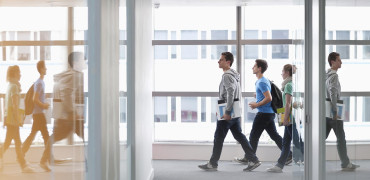The UK’s school and college buildings are in urgent need of repair.
According to the government’s figures, the bill is around £11 billion. HVAC and electrical improvements are at the top of the ‘must-do’ list, amounting to around £4 billion.
But updating the existing stock is more than just making these buildings functional for the next few years. The Department for Education (DfE) has also put the spotlight on ‘adapting these buildings to prepare for the effects of climate change in the UK’. This objective sits alongside a target emission cut of 50% (against a 2017 baseline) by 2032.
But it’s just as important, and perhaps more tangible to the people working, teaching and learning in those schools and colleges.
As a result, since April 2022, new buildings or blocks for the DfE estate must be Net Zero in operation. They must also be designed to cope with a 2oC rise in average global temperatures and future-proofed for a 4oC rise.
This includes delivering new school and college buildings adapted to risks such as flooding and higher indoor temperatures.
Ironically, building improvements for efficiency can make classrooms stuffier and hotter.
The future is already here
However, while new school buildings can be exemplars of energy and carbon performance, the largest proportion of the education building stock is already built and in daily use.
These buildings pose a real challenge, with extreme summer and winter temperatures becoming more common in the UK.
There are currently no legally enforced minimum or maximum temperatures for UK schools in the School Premises (England and Wales) Regulations (2012). Scotland sets a minimum temperature of 16oC in classrooms, although 18oC is recommended as the lowest temperature and rules in Northern Ireland are similar.
Other temperatures are recommended for different areas of a school or college building. For example, corridors which are usually unoccupied can be 11oC and spaces for physical exercise can also have lower temperatures. The National Education Union (NEU) advises that 18oC should be considered a safe minimum for classrooms.
The heat is on
Summer is an increasingly difficult time of year for classroom temperatures. With higher summer temperatures happening more frequently, classrooms can quickly soar to 30oC and above.
The NEU has been campaigning for a maximum indoor working temperature of 26oC, stating: “Even at lower temperatures likely to be experienced in classrooms, heat still leads to a loss of concentration and increased tiredness which means that teachers are more likely to put themselves and others at risk.”
It’s clear that ventilation will play an essential role in helping schools and colleges mitigate these challenges.
Ironically, building improvements for efficiency, such as insulation, can exacerbate the problem by unintentionally reducing ventilation – making classrooms stuffier and hotter.
So, it’s vital to think about ventilation systems such as MVHR (mechanical ventilation with heat recovery) alongside other building improvements.
Cooling AND heating
Air conditioning may be an option for some schools and college buildings. Each building is different, but the internal heat burden is growing in education facilities that increasingly use electronic whiteboards for teaching or with extensive ICT teaching areas.
There are suitable options for this: Heat pumps can provide cooling as well as heating, and modern VRF air conditioning systems, for example, are very energy efficient. And as they can also provide heating in cooler months, they can help to reduce the need for gas boilers on-site.
It may seem strange to consider air conditioning for schools in the UK (where taking blazers off was the old-fashioned response to hot summers), but we must be realistic about future weather conditions.
In June 2023, temperatures reached 30oC in parts of the country, setting a new record.
Free guide
We must start thinking about how our existing school and college buildings can work in these environmental conditions.
Building services such as heating, hot water and cooling are crucial for modern school and college buildings. They contribute to healthy, optimised spaces for teachers and students, now and in the future.
Mitsubishi Electric has produced a white paper on these issues, which aims to help school and college management teams understand the impact of building services on their energy use and carbon footprint.
In addition, it highlights the benefits of modern heating, cooling and ventilation systems. It explains how best to engage with contractors and installers when discussing the various options for upgrading existing systems.
Mike Egan is Business Development Manager




